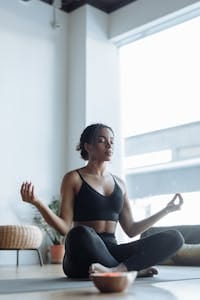FREE SHIPPING OVER $50
Forget the Gym: This 10-Minute Routine Fixes Your Balance for Good
When it comes to fitness, balance often takes a backseat to strength and cardio. Yet, having good balance is essential—it prevents falls, improves posture, and makes everyday movements easier. The best part? You don’t need fancy gym equipment or hours of your time to master it. This 10-minute routine will help you build steadiness, coordination, and confidence—all from the comfort of your home.
Why Is Balance Important?

Balance isn’t just for tightrope walkers or yoga enthusiasts. It plays a crucial role in overall health and fitness. Good balance improves your body’s stability, reduces the risk of injuries, and even enhances athletic performance. Plus, it strengthens your core muscles, which are the foundation of nearly every movement you make.
As we age, balance tends to decline naturally. Incorporating a quick routine like this one can keep you steady on your feet and even help you stay active longer.
The Science of Balance: What Happens in Your Body?
Balance is a skill that relies on coordination between your inner ear (vestibular system), eyes, muscles, and joints. These systems work together to maintain your body’s equilibrium. When one falters—like weakened muscles or poor posture—your stability suffers.
Fortunately, balance can be improved with regular practice. The key is engaging your core, improving proprioception (awareness of your body in space), and strengthening key muscles like your glutes and legs.
The 10-Minute Balance Routine
You don’t need any equipment for this routine, and it’s suitable for all fitness levels. Set aside a small space, wear comfortable clothes, and get ready to build a stronger foundation.
1. Single-Leg Stand (2 Minutes)
- Why it works: Strengthens your ankles, calves, and core while improving proprioception.
- How to do it:
- Stand on one leg with your other leg bent at the knee.
- Keep your gaze forward and your arms by your sides or slightly extended for balance.
- Hold for 30 seconds, then switch legs. Repeat twice per leg.
2. Heel-to-Toe Walk (2 Minutes)
- Why it works: Improves coordination and strengthens your lower body.
- How to do it:
- Walk in a straight line, placing your heel directly in front of your opposite toe with each step.
- Take 20 steps forward and then return to your starting position.
- Keep your arms out for stability if needed.
3. Side Leg Raises (2 Minutes)
- Why it works: Activates your glutes and hips, crucial for lateral stability.
- How to do it:
- Stand upright with your hands on your hips or holding a wall for support.
- Slowly lift one leg to the side without leaning your torso.
- Lower your leg and repeat 10 times per side.
4. Bird Dog Pose (2 Minutes)
- Why it works: Enhances core stability and challenges coordination.
- How to do it:
- Start in an all-fours position with your hands under your shoulders and knees under your hips.
- Extend your right arm and left leg simultaneously. Hold for a second, then return to the starting position.
- Alternate sides and repeat 10 times.
5. Toe Taps (2 Minutes)
- Why it works: Improves ankle mobility and foot strength, which are essential for balance.
- How to do it:
- Stand tall near a sturdy surface for support.
- Tap your right foot in front of you, to the side, and behind you in a controlled motion.
- Switch legs after completing 10 taps in each direction.
How to Make This Routine a Habit
Consistency is key to seeing results. Here are some tips to make this routine part of your daily life:
- Start small: Aim for three times a week, then gradually increase frequency.
- Pair it with another habit: Do this routine while watching TV or listening to your favorite podcast.
- Track your progress: Note improvements in how long you can hold a single-leg stand or how steady you feel during heel-to-toe walks.
Common Mistakes to Avoid
Balance training seems simple, but there are a few common pitfalls:
- Holding your breath: Breathing deeply and steadily helps maintain control.
- Rushing through movements: Perform each exercise slowly to engage the right muscles.
- Skipping warm-ups: Warming up reduces stiffness and improves your range of motion.
Who Can Benefit From Balance Training?
Everyone! Whether you’re a beginner, athlete, or senior, balance training offers significant benefits:
- Beginners: Builds foundational strength and confidence for more advanced workouts.
- Athletes: Improves performance in sports that require agility and quick direction changes.
- Seniors: Reduces fall risk and maintains mobility for daily activities.
Why You Don’t Need the Gym for This
Gyms are great for heavy lifting and cardio machines, but balance training is different. It focuses on coordination and stabilization, which don’t require big equipment. In fact, practicing balance in natural, everyday settings can be more effective than using machines.
The Benefits of Balance Training
Still not convinced? Here’s what regular balance exercises can do for you:
- Better posture: Aligns your body to prevent aches and pains.
- Enhanced athletic performance: Boosts agility and reaction time.
- Injury prevention: Strengthens stabilizing muscles to reduce strain during other activities.
Final Thoughts
Balance training might not have the glamour of weightlifting or the thrill of HIIT workouts, but it’s just as essential. With this simple 10-minute routine, you can improve your stability, prevent injuries, and feel more confident in your movements—all without leaving your home.
Related Articles
- Stop Ignoring Rowing: Here’s Why It’s the Only Workout You Need in 2025
- Stop Wasting Time on Calf Raises—These 5 Moves Will Actually Get You Results
- Farmers Carry Workout Explained: The Simple Move That Builds Serious Muscle
- Forget Sit-Ups—These 5 Moves Will Torch Your Core (And Your Excuses) in 30 Minutes
- Certified Trainer Spills: The Exercise Everyone’s Ignoring (But Totally Shouldn’t Be)



